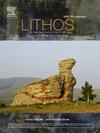Sources of alkaline and tholeiitic basaltic magmas of Changbaishan volcanic area (Northeastern China)
IF 2.9
2区 地球科学
Q2 GEOCHEMISTRY & GEOPHYSICS
引用次数: 0
Abstract
Changbaishan volcanic area (China-North Korea) is located on the margin of the Eurasian continent within the large Cenozoic intraplate province of Central and Eastern Asia. Two large volcanoes Wangtian'e and Changbaishan of the area are situated 30 km from each other in Northeastern China. Basalts of Wangtian'e volcano belong to the tholeiitic rock series as well as basalts of Changbaishan volcano belong to the alkaline one. In this paper we use data on chemical and isotopic (Pb, Sr, Nd) composition of tholeiitic and alkaline basalts to reconstruct magmatic sources that participated in the tholeiitic and alkaline rock formation. Isotopic and geochemical features of tholeiitic and alkaline basalts of the Changbaishan volcanic area indicate the participation of three different sources in their formation. The formation of tholeiitic and alkaline melts of the Changbaishan volcanic area occurred within the mechanical asthenosphere-lithosphere boundary layer at a depth of 30–75 km in two stages. The first stage corresponds to the melting of supra-subduction peridotite of the lithospheric mantle and eclogite lenses resulted in the formation of tholeiitic melts that formed Wangtian'e volcano. As the eclogite was exhausted, the resulting tholeiitic melt reacted with fertilized mantle peridotite producting pyroxenite source. The second stage corresponds to the partial melting of pyroxenite together with peridotite of the asthenospheric mantle, which led to the appearance of alkali-basaltic melts that participated in the formation of Changbaishan volcano.
求助全文
约1分钟内获得全文
求助全文
来源期刊

Lithos
地学-地球化学与地球物理
CiteScore
6.80
自引率
11.40%
发文量
286
审稿时长
3.5 months
期刊介绍:
Lithos publishes original research papers on the petrology, geochemistry and petrogenesis of igneous and metamorphic rocks. Papers on mineralogy/mineral physics related to petrology and petrogenetic problems are also welcomed.
 求助内容:
求助内容: 应助结果提醒方式:
应助结果提醒方式:


